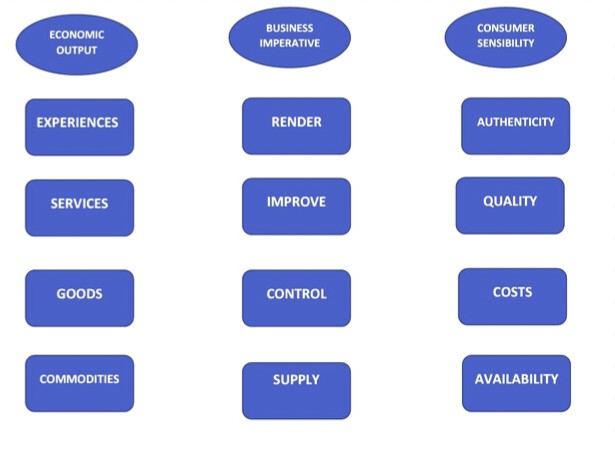
This blog is all about fundamental change that is going on in the of modern economy. And to talk
about that I am going to go back to the beginning, because in the beginning were commodities.
Commodities are things that you grow in the ground and pull out of the ground: basically animal,
mineral, vegetable. And then value extract them out of the ground, and sell them on the open
marketplace. Commodities were the basis of the agrarian economy that lasted for millennia. In the
time of economic revolution, goods became the predominant economic offering, where we used
commodities as a raw material to be able to make or manufacture goods. So, we moves from an
agrarian economy to an industrial economy. Over the last years, goods became commoditized.
Commoditized means where they’re treated like a commodity, where people don’t care who makes
them.
They just care about one thing only and that is “price”. Now there is an antidote to commoditization,
and that is customization. In the modern economy this has been realized that goods automatically turn
into services. This transformation converts industrial economy to a service- based economy. But over
the past 20 years, the services are being commoditized as well. The basis of selling telephone services
are price, restaurants are value based pricing. It’s time to move to a new level of economic value now.
This is the time to go beyond the goods and the services and focus on experiences. What happens
when you customize a service and design a service that is so appropriate for a particular person- that’s
exactly what they need at this moment in time? Then you can’t help but make them go “wow”; you
can’t help but turn it into a memorable event; you can’t help but turn it into an experience. Marketing
world is shifting to an experience economy, where experiences are becoming the predominant
economic offering.
Experiences you can more understand by Disney- the world’s premier experience. There are
numerous examples of experiences like theme restaurants, and experiential retail, and boutique hotels,
Las Vegas- the experience capital of the world. But when we think about experiences, think about
meaningful places, think about a journey to the clock of the long now. Those are all experiences.
There is no such thing as an inauthentic experiences. Why? Because experience happens inside of us.
The reaction to the events customer experience should be focus of marketing efforts that is called
authenticity. Now, there is more or less natural or artificial stimuli for the experience, but even that is
a matter of degree. There is no such thing as a 100 percent natural experiences.
Authenticity becoming the new consumer sensibility—the consumer buying criteria of choosing any
service or product depends upon authenticity. If we look at the developed economies consumer
sensibility and authenticity becomes the important
to influence consumer behavior. Service economy means quality improvement in respect of goods and
services. Over the last 20 years whole quality movement has risen with the service economy. In the
era of experience economy, it’s about rendering authenticity.
Assistant Professor, IILM-AHL, Jaipur

Figure 1: Consumer Behaviour in Modern Economy
Rendering authenticity—and the keyword is “rendering”. Rendering because you have to get your
consumers as business people to perceive your offering as authentic. Businesses are manmade objects;
and involved with money; also involve using machinery and all those things make something
inauthentic. So, this is a big question that How do you render authenticity. Are you rendering
authenticity? “Sincerity and Authenticity came out in 1960, points to as the seminal point at which
authenticity entered the lexicon. In Sakespeare play, ‘Hamlet’ there is the one part, Hamlet, where the
most fake of all the characters in Hamlet, Plonius, says something profoundly real. At the end of
laundry list of advice he’s giving to his son, Laetes, he says this: And this above all: to thine own self
to be true and it doth follow, as night the day, that cannot then be false to any man. Those three verses
are the core of authenticity. There are two dimensions to authenticity: 1. Being true to yourself, which
is very self-directed. 2. Being true to yourself, which is other-directed. That means being what you
say you are to others and don’t know about you, but whenever you encounter two dimensions, you
immediately go two by two dimensions. Where, one dimension it‘s matter of being true to yourself.
Ultimately the customers are buying experiences. Therefore, authenticity is becoming the new
consumer sensibility. There are three basic rules-
- Don’t say your service is authentic unless it is really authentic.
- It’s easier to be authentic, if you don’t say that your service is authentic.
- If you say your service is authentic, your company service is better to be authentic.
I conclude this all what consumers will make happy is spending their time and money for satisfying
the desire of authenticity.






